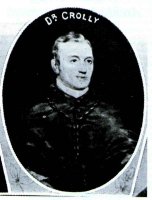 William Crolly was born at Ballykilbeg, near Downpatrick on 8 June, 1780. As there were no Catholic schools available he attended a classical school in Downpatrick, conducted by Rev. Mr. Nelson, a Unitarian minister. He went to Maynooth in 1901 obtaining first place in dogmatic theology in 1806.
William Crolly was born at Ballykilbeg, near Downpatrick on 8 June, 1780. As there were no Catholic schools available he attended a classical school in Downpatrick, conducted by Rev. Mr. Nelson, a Unitarian minister. He went to Maynooth in 1901 obtaining first place in dogmatic theology in 1806.
In the same year he was ordained priest by Dr. Troy, Archbishop of Dublin, and for six years lectured in logic, metaphysics, and ethics. In 1812 moved to the parish of Belfast, which comprised not only the entire town but also a district more than thirty miles in extent. On being appointed Bishop of Down and Connor in 1825, he persuaded the Vatican to change the episcopal parish from Downpatrick to Belfast, where the real centre of the diocese lay. While there he built a large church in almost every parish, and founded St. Malachy's Seminary. Owing to the dearth of Catholic schools, Dr. Crolly was obliged to allow Catholic children to attend Protestant schools, a course of action that caused a fierce controversy after his death.
In 1835 he was appointed to the archdiocese of Armagh. In 1838 he founded St. Patrick's Seminary in Armagh. His great work however, was the foundation of the cathedral, which was not completed till twenty-four years after his death. Having with great difficulty acquired a site on an historic hill by the side of the town, he laid the foundation stone on St. Patrick's Day. The work of construction went steadily on until the famine years, and the primate visited several cities in Ireland, making an appeal in person. The famine, however, stopped the progress of the work.
When the question of the Queen's colleges arose, the primate was one of those bishops who looked favourably on the project. It was however formally condemned by the Vatican as pernicious to the Faith.
He died in Drogheda of the cholera on 6 April 1849, and was buried in the centre of the choir of the still unfinished cathedral of Armagh.
A blue plaque to Archbishop Crolly was erected on Ballykilbeg Church on 1 June 2004 by The Ulster History Circle.